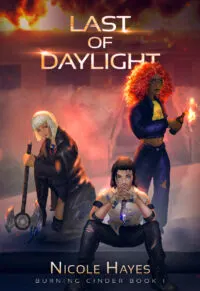Last of Daylight: Burning Cinder Book I by Nicole Hayes

In 2006 of an alternate universe, aliens invade Earth. They’re bent on enslaving the human race for their vampirish appetites. They meet resistance in the way of five young men and women trained well by their mentor—A member of the invading race dedicated to uniting the worlds for the betterment of the galaxy. But as the warriors progress in their fight, they learn every story has two sides, and no one turns to desperate conquest overnight. What more is there to the the planet known as Cinder and the beings known as Icari? And what agents are driving the collision of these worlds?
Rayne and her friends lived somewhat normal lives until an alien warned them of his race’s oncoming invasion. Fortunately, he trains them to fight it back. Unfortunately, Nox, King of Cinder, accounted for this in his plans to claim Earth.
Our five fighters never expected the aliens, affected by sunlight, to attack them at school during the day. Unprepared, they find the horde are much harder to kill than they were taught in training. And their trainer suspiciously disappeared four months prior to the assault.
Last of Daylight: Burning Cinder Book I Review
I was compensated with a small amount for writing this review in exchange for my time and effort. However, all thoughts and opinions expressed are my own and are based on my honest personal experience reading the book. Nor did the publisher in any way shape or form ever pressure me to give a positive review.
This is a bit irrelevant from the book review itself, but I can’t help but mention that it’s quite funny how I’ve been reading so many alien invasion stories for my book reviews lately. Maybe alien invasion is all the hype these days, perhaps it’s all because of the congressional briefing (just kidding).
Back to the review. The premise of the book is undeniably captivating, thrusting readers into an alternate universe where Earth faces a formidable alien invasion in 2006. The concept of extraterrestrial beings with vampiric appetites adds a unique twist, and the resistance mounted by five young warriors, mentored by a member of the invading race with a vision for uniting worlds, sets the stage for an intriguing narrative.
As I followed Rayne and her friends navigating their suddenly tumultuous lives, the story unfolded with unexpected twists and turns. The looming threat of invasion provided a dynamic backdrop, making it genuinely fun to follow. The desire to uncover the mysteries of Cinder, the motives behind the invasion, and the enigmatic Icari beings propelled my interest, compelling me to delve deeper into the narrative and leaving me eager to finish the book to unravel the secrets driving the collision of these two worlds.
One of the biggest initial impressions was that this book jumped right into the story with no delay or hesitation. The main theme of aliens was immediately apparent. Lately, I’ve grown accustomed to books dragging out their introductions before reaching the actual plot, so this direct approach caught me off guard (in a good way). I had to backtrack and re-read, but I appreciate the book getting straight to the point.
However, shortly after beginning, I noticed a significant pacing issue. The book seemed to jump between characters too quickly, too fast, and too often. Within the first eight pages, three different characters were introduced (Rayne, Tameka, and then Sagan), and this trend continued throughout the introduction and up to the end of Chapter Two. Personally, I found this format a bit jarring. Perhaps it’s because I’m not familiar with it, but it felt too rapid and gave me a bit of whiplash. I’m not a fan of this writing style. While switching points of view between multiple characters is common in science and fantasy fiction, providing a more holistic picture, this particular formatting and pacing didn’t work for me.
As a result, the story’s romantic aspects are also detached because of the fast-paced narrative, which prevents relationships from developing naturally and exploring their potential. The brief interactions I have with the characters and the rapid pace of the story prevent me from connecting with and getting invested in the romantic undertones of the narrative. A slower pace through lengthening each POV of the character cast might make the reading experience more immersive and help the reader develop a true bond with the characters and the romantic aspects of the plot.
Despite the faults, this book still has its positive attributes. Although it has a large cast, the characters are not overly superficial. Their portrayal did not feel thin, and individually, they effectively showcased different perspectives in the story. This is crucial, especially considering the book’s theme that no one is truly the “villain” or “hero” of the conflict. However, the pacing and POV switching issue was a significant drawback, detaching me from the characters before I could fully immerse myself. It’s a substantial issue.
And as the book progressed, there were moments where the pacing became better, especially when switching between characters in the same overlapping situation, like two parties sharing the same conversation and it’s like constantly seeing the inner reactions from both parties in a scenario (I hope this example make sense, I do apologize it sounds weirdly vague but I am trying to avoid spoilers).
I did enjoy the book, but the pacing made it a 3.8-star experience for me. I could have been more immersed if the pacing hadn’t interrupted my reading momentum. Apart from the pacing issue, the writing quality itself was quite good. The dialogue was natural, the writing flowed well, and nothing felt awkward or out of place. I also didn’t notice any technical errors with grammar or sentence structure. Overall, it’s a pleasant read, but the pacing issue led me to rate it 3.5 stars out of 5.
If you liked this review and want to see other book reviews like this one, check out my book reviews collection!

